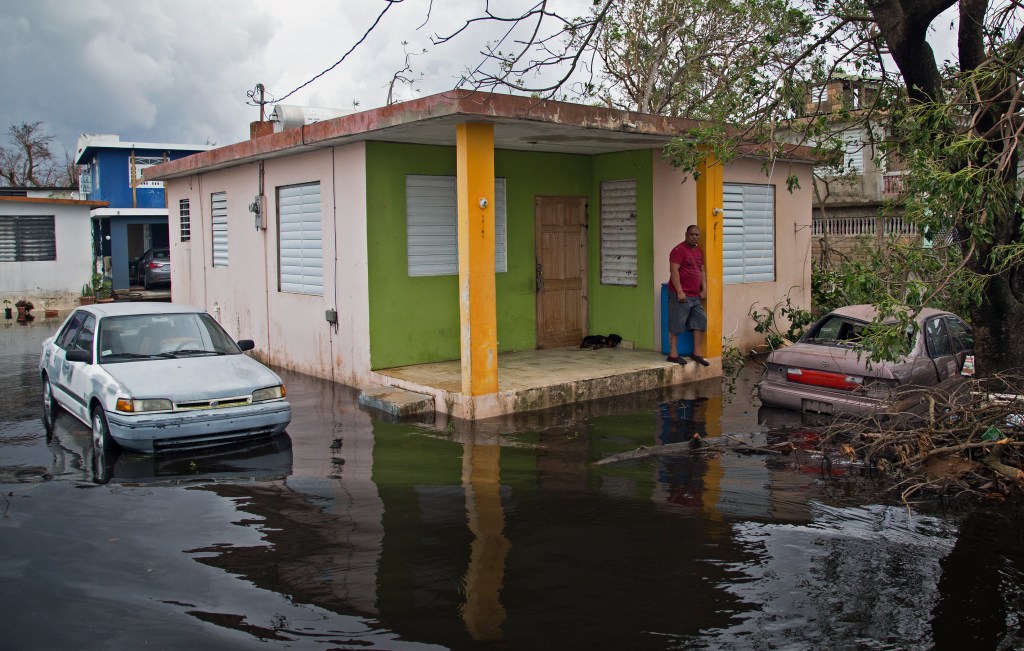After three hard-hitting hurricanes in a span of six weeks, governments at all levels are facing a heavy lift to put the Texas coast, the Florida Keys, and the entire island of Puerto Rico back on their feet. Puerto Rico remained in critical shape this week after a direct hit from Hurricane Maria, and military and civilian relief efforts were still struggling to get organized. USA Today had this report (see: “U.S. military dispatches three-star general to Puerto Rico amid charges of supply snafus,” by Doug Stanglin). “This is the single biggest, major catastrophe in the history of Puerto Rico, bar none, and it is probably the biggest hurricane catastrophe in the United States,” Puerto Rico Governor Ricardo Rosselló said Wednesday. Supplies reaching the island were stuck in port, with delivery efforts hampered by destroyed roads, power failure, and non-existent telephone service.
“On Puerto Rico, the desperation and frustration only grew,” reported The New York TImes (see: “Trump Administration Is Pressed to Step Up Hurricane Recovery in Puerto Rico,” by Helene Cooper, Julie Hirschfeld Davis, and Jack Healysept). “Shelters ran out of supplies and residents lined up all night to purchase ice and fuel, only to walk away with a bag of cold water or just a few gallons of gas. Others complained of an absence of basics like tarps for roofs and the continuing lack of running water.”
There was good news for Florida last week: Wind damage from Hurricane Irma was relatively moderate, and the insurance industry—in particular, Citizens Property Insurance, the state-backed company that insures Florida’s high-risk pool—reported that it’s in good financial shape to handle claims without dipping into emergency funding sources. The Miami Herald had this report (see: “Florida taxpayers may not be on the hook to keep Citizens whole after Irma claims,” by Jim Turner). The Sun-Sentinel reported, “Citizens Insurance now projects 70,000 claims from Hurricane Irma — less than half its original post-storm estimate of 150,000.” (see: “Citizens’ cuts its Hurricane Irma claims projection by more than half to 70,000,” by Ron Hurtibise). “Citizens estimates the total insured value of the 70,000 projected Irma claims will be $1.23 billion—easily manageable for the company,” the Sun-Sentinel reported. “The company was sitting on a surplus of $7.4 billion at the end of 2016, along with significant reinsurance—which is insurance that insurance companies buy.”
But the FEMA-backed National Flood Insurance Program (NFIP) is a different story. FEMA has run through its borrowing authority, Politico reported on September 28 (see: “Flood insurance program exhausts Treasury borrowing,” by Zachary Warmbrodt). “The balance of FEMA’s remaining borrowing authority is now zero, according to the agency,” Politico reported. “Congress last raised its borrowing cap to about $30 billion after Hurricane Sandy.” In Houston, flooded homeowners hoping for FEMA’s help are hitting roadblocks, reported local station KHOU (see: “Homeowners frustrated by FEMA fund denials after Harvey,” by Jason Miles). FEMA grants for damage to uninsured homes are capped at $33,000, the station notes; one man reported receiving $11 from the agency.
